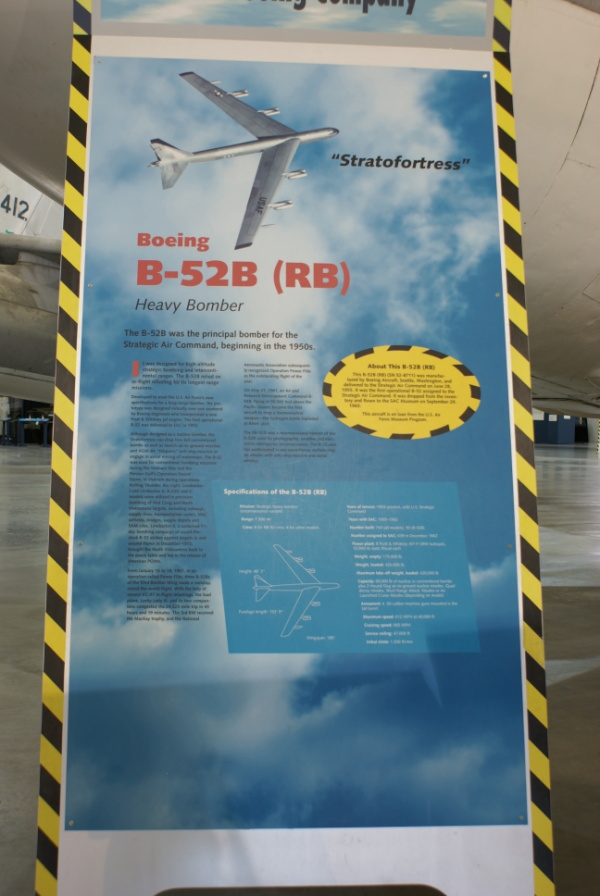| Prev |
heroicrelics.org Strategic Air Command & Aerospace Museum Site Index B-52 Gallery |
Next |
dsc44605.jpg
The sign accompanying the aircraft. It reads
"Stratofortress"
Boeing
B-52B (RB)
Heavy BomberThe B-52 was the principal bomber for the Strategic Air Command, beginning in the 1950s.
It was designed for high-altitude strategic bombing and intercontinental ranges. The B-52B relied on in-flight refueling for its longest range missions.
Developed to meet the U.S. Air Force's new specifications for a long-range bomber, the prototype was designed virtually over one weekend by Boeing engineers who incorporated a new Pratt & Whitney jet engine. The first operational B-52 was delivered to SAC in 1955.
Although designed as a nuclear bomber, the Stratofortress can drop free-fall conventional bombs as well as launch air-to-ground missiles and AGM-84 "Harpoon" anti-ship missiles or engage in aerial mining of waterways. The B-52 was used for conventional bombing missions during the Vietnam War and the Persian Gulf's Operation Desert Storm. In Vietnam during operations Rolling Thunder, Arc Light, Linebacker I and Linebacker II, B-52D and G models were utilized in precision bombing of Viet Cong and North Vietnamese targets, including railways, supply lines, transportation routes, MiG airfields, bridges, supply depots and SAM sites. Linebacker II, a sustained 11-day bombing campaign of round-the-clock B-52 strikes against targets in and around Hanoi in December 1972, brought the North Vietnamese back to the peace table and led to the release of American POWs.
From January 16 to 18, 1957, in an operation called Power Flite, three B-52Bs of the 93rd Bomber Wing made a nonstop, round-the-world flight. With the help of several KC-97 in-flight refuelings, the lead plane, Lucky Lady III, and its two companions completed the 24,325-mile trip in 45 hours and 19 minutes. The 3rd BW received the MacKay trophy and the National Aeronautic Association subsequently recognized Operation Power Flite as the outstanding flight of the year.
On May 21, 1961, an Air and Research Development Command B-52B, flying at 50,000 feet above the Pacific Ocean, became the first aircraft to drop a thermonuclear weapon -- the hydrogen bomb exploded at Bikini atoll.
The RB-52B was a reconnaissance version of the B-52B used for photographic, weather and electronic intelligence reconnaissance. The B-52 also has participated in sea surveillance, surface-ship air attacks with anti-ship missiles and aerial mining.
About This B-52B (RB)
This B-52B (RB) (SN 52-8711) was manufactured by Boeing Aircraft, Seatle, Washington, and delivered to the Strategic Air Command on June 28, 1955. It was the first operational B-52 assigned to the Strategic Air Command. It was dropped from the inventory and flown to the SAC Museum on September 29, 1965
This aircraft is on loan from the U.S. Air Force Museum Program.
Specifications of the B-52B (RB)
Mission: Strategic heavy bomber (reconnaissance variant)
Range: 7,500 mi
Crew: 8 for RB-52 crew, 6 for other models
Height: 48' 3"
Fuselage length: 152' 9"
Wingspan: 185'
Years of service: 1953-present, with U.S. Strategic Command
Years with SAC: 1955-1992
Number built: 744 (all models), 50 (B-52B)
Number assigned to SAC: 639 in December 1962
Power Plant: 8 Pratt & Whitney J57-P-29W turbojets, 10,900-lb static thrust each
Weight, empty: 175,000 lb
Weight, loaded: 420,000 lb
Maximum take-off weight, loaded: 420,000 lb
Capacity: 65,000 lb of nuclear or conventional bombs, plus 2 Hound Dog air-to-ground nuclear missiles, Quail decoy missiles, Short Range Attack Missiles or Air Launched Cruise Missiles (depending on model)
Armament: 4 .50-caliber machine guns mounted in the tail turret
Maximum speed: 612 MPH at 40,000 ft
Cruising speed: 565 MPH
Service ceiling: 47,000 ft
Initial climb: 1,500 ft/min

| Time picture taken | Sun Jul 27 14:09:50 2008 |
| Location picture taken |
Hangar A Strategic Air & Space Museum Ashland, NE |
| Prev |
heroicrelics.org Strategic Air Command & Aerospace Museum Site Index B-52 Gallery |
Next |